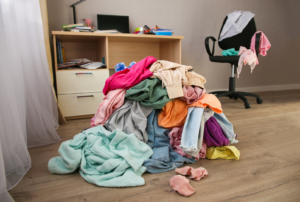The term “floordrobe” gained popularity on social media this year after ADHD coach Jeff Rice described it in a TikTok video that has been viewed more than five million times. People with ADHD often struggle keeping their clothes off the floor, he claims.
“A ‘floordrobe’ is a place, typically on the floor, where we leave either clean or ‘not quite dirty’ clothes,” Rice says. “It can be in a laundry basket that just sits there for days and days or weeks, or it can be in a pile of clothes that you’ve worn for a little while, but they didn’t quite get dirty. And so, you think you’re going to wear them again, and so you leave them sitting on the floor or hanging over a chair or whatever.”
Floordrobe, a combination of the words floor and wardrobe, describes the pile of clothes stashed on the bedroom floor or elsewhere in one’s home. A floordrobe can be a symptom of ADHD. However, having a floordrobe doesn’t necessarily mean that you have ADHD. ADHD can only be diagnosed by a medical professional who specializes in the condition.
“ADHD floordrobes exist for two reasons, I think,” Rice supposes. “The first has to do with the clothes which are not quite dirty. Usually, we leave these things out because it’s going to act as a visual cue to remind us, ‘this is not quite dirty, and I want to wear it again.’ The problem with visual cues is we become visually adapted to them after we’ve seen them a couple of times and haven’t acted on them. So, our dirty clothes accumulate into a floordrobe somewhere.”
“Another common reason is because the act of putting away clean clothes is one that our ADHD brains just do not get attracted to—it’s not interesting, novel—so we put it off until maybe it does become urgent because all four laundry baskets are full and you have to do laundry,” he says. Then, after pausing, he adds, “I’m not saying that ever happens to me…”
High- and low-interest tasks
Floordrobe is a trendy term for a challenge that many people have struggled with for a long time. It has long been recognized as a symptom of ADHD. Adults and children with ADHD often have trouble doing routine tasks because of difficulties with executive function skills like focusing, paying attention, and organization.
Vidya Guhan, a master certified coach, speech pathologist, and founder of Calm Seas ADHD Coaching, describes why you or your child might have trouble completing mundane tasks.
“When the task or activity is of low interest—even if it is important, simple, or short—[people with ADHD] find it viscerally painful and almost impossible to engage with,” she says.
Individuals who have ADHD can complete chores but often struggle when the chore seems boring. The reverse is true, she says, of high-interest tasks.
Struggling to complete a task doesn’t just apply to putting away one’s clothes. You may have trouble with things like sorting mail, paying bills, doing the dishes, or putting away groceries. Failing to do household chores can lead to a cluttered home or cause problems in your relationships.
Dopamine plays a key role in getting things done. The more dopamine your brain can access, the greater your ability to focus and complete a task. When it comes to picking up the clothes off the floor, something in which you’re not too interested, your brain may lack enough dopamine to get the job done.
Think about it another way: If your child has little interest in math (low dopamine), they may have difficulty paying attention in class or fail to complete homework assignments. But they may love reading and as a result finish several books a month (high dopamine).
Finding motivation
How do you get motivated to do the chores that you really don’t want to do but that you know need to be done? ADHD coach Amy Voros, PCC, suggests starting small; pairing a new action with one you already do and following up with a reward.
For example, she paired a chore she usually does with a chore she dislikes doing. Every time she loads the dishwasher (something she already does), she handwashes a dish (new behavior). She believes that by creating these tiny habits over time, she will accomplish more tasks that previously were difficult for her to complete.
It’s also important, she says, to celebrate no matter how small the task you’ve completed.
“And celebrating is acknowledging that I’ve done what I intended, and creating a dopamine hit tells my brain that it should remember these actions as a positive event to repeat. Emotions create habits, not repetition,” says Voros.
A floordrobe-conquering suggestion
If you’re still not sure how to tackle that pile of clothes on the floor, try thinking about it differently, says Arthur Robin, PhD, a professor of psychiatry and behavioral neurosciences and pediatrics at Wayne State University. He has worked with many adults and children who struggle to clear their floordrobes.
“The clothes storage environment needs to be redesigned for individuals with ADHD,” says Dr. Robin. He offers the following suggestion if you struggle to conquer the mess.
Try reorganizing your room so that clothes are kept on an inexpensive, portable clothing rack with wheels. This strategy keeps it simple because you can wheel the clothing rack to the laundry room, if it is on the same floor as the bedroom, or as close to it as possible, allowing clothes to go directly from the dryer to the clothing rack in one step.
Once all your clean clothes are on the rack, you can wheel it back to your closet.
“If putting the clothes on hangers takes too much time and effort, you can just drape them over the top of the rack,” he adds. “The clothes are always visible, and they still look neater than a floordrobe.”
Looking for more ideas to get started?
- If This Is Supposed to Be Easy, Why Is It So Hard?
- Making Things Easier with Tiny Habits
- Foraging for Information
- Demonstrate and Encourage Better Organization Strategies
- Organizing the Home and Office Space
- Embrace Miscellaneous Organization for Your Ideas
- Focusmate: Virtual Coworking
Join the conversation: How have you tackled your floordrobe?


